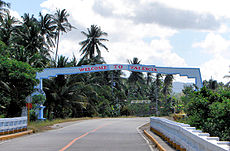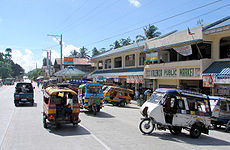
Valencia, Bohol
Encyclopedia


Philippines
The Philippines , officially known as the Republic of the Philippines , is a country in Southeast Asia in the western Pacific Ocean. To its north across the Luzon Strait lies Taiwan. West across the South China Sea sits Vietnam...
. According to the 2007 census, it has a population of 28,043 people. It is on the southern coast of Bohol, 42 kilometres (26.1 mi) from the capital Tagbilaran City
Tagbilaran City
Tagbilaran City is a 2nd class component city in the island province of Bohol, Philippines and serves as its capital. Tagbilaran lies on the southwestern part of the province, and has a total land area of 32.7 km², with about 13 km of coastline...
.
For the education of the children there are elementary schools in the poblacion and in the barrios. For their secondary education, students may go to the Valencia High School, a public school.
Valencia is the birthplace of former Executive Secretary Juan Pajo.
History
Its former name is said to be "Panangatan," which is derived from "Sang-at", meaning to put up on an elevated place. It is said that many years ago, on windy days, fishermen from Dimiao and Lila used to seek shelter at the mouth of the Panangatan River when the southwest monsoon was very strong. Here they would put up (sang-at) their boats on the banks of the river where nipa palms grew in order to prevent them from being washed away by the waves. When the Spaniards came, Panangatan was still a part of Dimiao. It was separated in 1867, the year a Spanish priest was assigned to the municipality. The priest gave it the new name, named after the seaport city in Spain. In 1879 Valencia had a population of 7,009.Economy
The principal industries of the people today are weaving, pot making, and fishing. The most important products are coconuts, rice, corn and fish. The Badiang Spring Resort — a popular seaside resort with a waterfall and swimming pools — creates some tourism by attracting local excursionists and foreign visitors.The market day, locally known as Tabu is held weekly every Sunday. Local produce such as fresh fruits, vegetable, fresh meat and live poultry are sold. The days of this weekly community occasion differ from town to town.
Barangays
Valencia is politically subdivided into 35 barangayBarangay
A barangay is the smallest administrative division in the Philippines and is the native Filipino term for a village, district or ward...
s.
|
|
|
Valencia Parish Church
The parish of the Santo Niño and the town of Valencia began as Barrio Panangatan of Dimiao. Conjoined with adjacent barrios, it was constituted a town in 1869 and a parish in 1871 and named after a city on Spain’s southern coast. The church building commenced during the term of Fray Mariano Cornago (1870-77) and was completed in 1882 by Fray Francisco Arraya, who laid the church’s wooden floor. The church walls were of tabique but were later replaced by cement.Heritage Site: The church is cruciform with a steep roof and a pyramidal crossing tower. Cut stone is used in parts of the church like the façade, however, concrete is found elsewhere. The real treasure of the church is its wooden floor of alternating dark (tindalo or balayong) and light (molave or tugas) wood planks. At the transept crossing an eight pointed flower design is used for the floor while, a herringbone pattern is used elsewhere. The interior is unpainted, unlike most Bohol churches and has altars in the neoclassical idiom.
The convent is located not beside the church as customary but across the street. This structure was renovated in the 19th century. Just recently, the local church leadership has caused the fencing of the entire vicinity of the convent.

